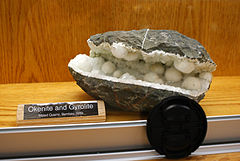- Okenite
-
Okenite 
OkeniteGeneral Category silicate Chemical formula CaSi2O5·2H2O Crystal symmetry triclinic Identification Color white to slightly yellow, blue Cleavage perfect on {001} Mohs scale hardness 4½-5 Luster vitreous, pearly Diaphaneity transparent, translucent Specific gravity 2.28 - 2.33 Okenite (CaSi2O5·2H2O)[1] is a silicate mineral that is usually associated with zeolites. It most commonly is found as small white "cotton ball" formations within basalt geodes. These formations are clusters of straight, radiating, fibrous crystals that are both bendable and fragile.[2] Other minerals associated with okenite include apophyllite, gyrolite, prehnite, chalcedony, goosecreekite and many of the other zeolites.
It was first described in 1828 for an occurrence at Disko Island, Greenland and named for German naturalist Lorenz Oken (1779-1851).[3]
Occurrence
Okenite is largely found in India, mainly within the state of Maharashtra. Other localities include Bulla Island, Azerbaijan; Aranga, New Zealand; Chile; Ireland and Bordo Island in the Faroe Islands.[1]
References

This article about a specific silicate mineral is a stub. You can help Wikipedia by expanding it.
